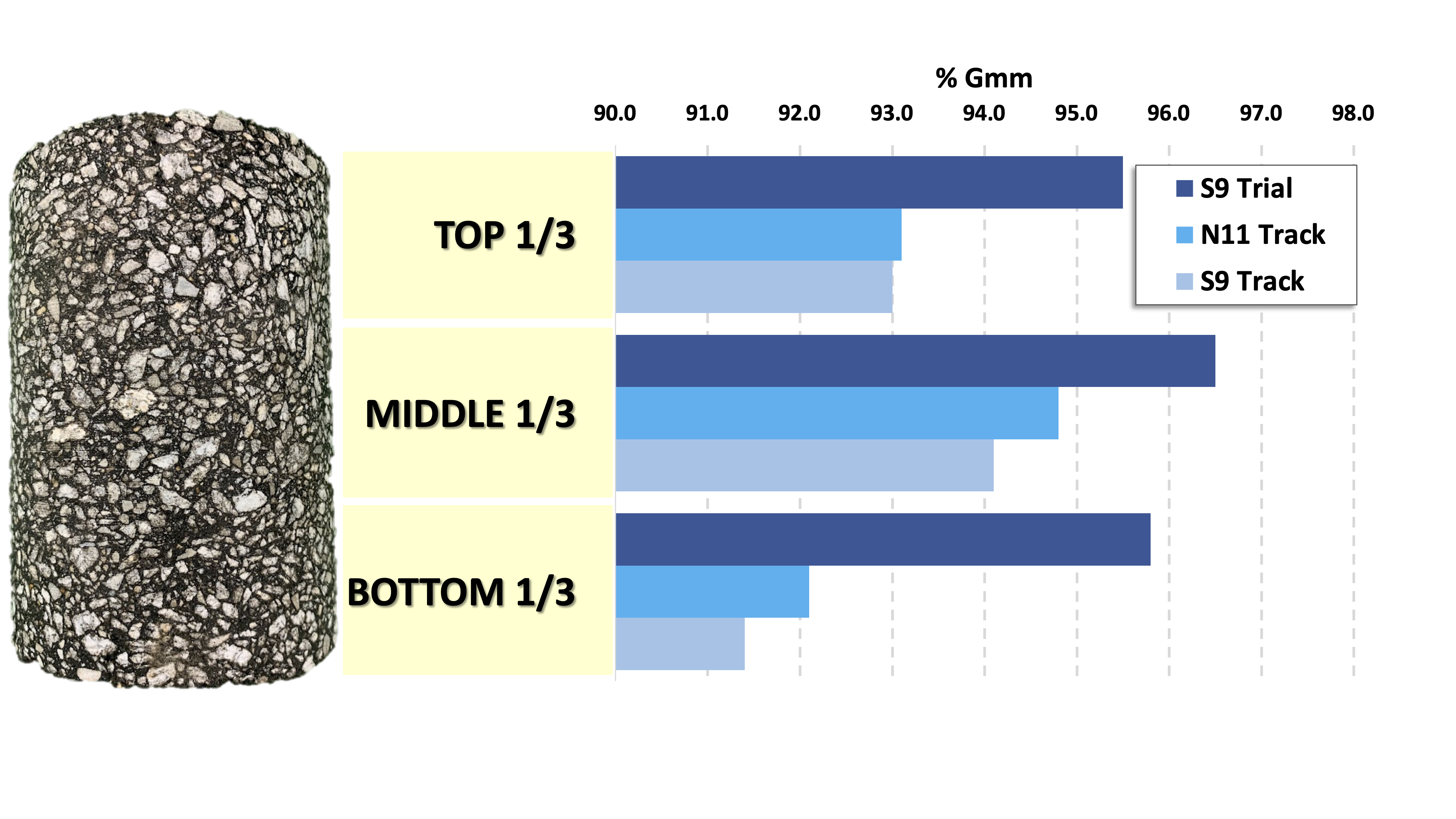- Spring 2022
Implementation Spotlight: Paving Thick Lifts for Deep Rapid Rebuilds

Installing instrumentation for thick lift paving in SCDOT’s Test Track Section S9.
Research has shown that the minimum thickness of a plant-mix asphalt paving lift should be three times the nominal maximum aggregate size (NMAS) of the aggregate blend for fine-graded mixtures and four times the NMAS for coarse-graded mixtures. Lift thicknesses thinner than this are difficult to compact due to aggregate packing. However, there is little guidance on a maximum lift thickness.
Some pavement engineers suggest that it may not be possible to achieve the necessary density throughout lifts that exceed five times the NMAS. Contractors may share this concern because of the limited measurement depth of nondestructive density gauges. Despite this, some anecdotal success has been reported with thick lift paving. The South Carolina Department of Transportation (SCDOT) decided to evaluate the feasibility of paving thick lifts on the 2018 NCAT Pavement Test Track to consider the practice as an option for the rapid rebuild of failed truck lanes.
Because of their success with thick lift patching of the truck lane on I-85 in Greenville-Spartanburg, SCDOT suspected thick lifts could work for full depth reconstruction. The completely failed lane required full depth reconstruction accomplished using multiple lifts, each up to 4½”. Their positive experience with the density and smoothness of those repairs encouraged SCDOT to experiment with even greater thicknesses on the NCAT Test Track. If proven to work, thick lift paving would be an alternative to cold recycling that could avoid pavement edge drop-offs with complete overnight reconstruction of relatively short (e.g., 1000- to 2000-foot) segments. Additionally, they could validate the use of thick lift paving as an option to create strong shoulders that could quickly be built for temporary traffic.
For thick lift paving to work, SCDOT needed to place a mix that could immediately support heavy traffic using a fine gradation for compactability and to avoid permeability issues. Based on the success of the I-85 rebuild, a 12.5 mm NMAS Type B intermediate special surface mix (typically placed at a thickness of only 2”) containing 25% RAP and PG 64-22 virgin binder was specified for placement on the track. Design air voids were dropped to 2.5% and design gyrations were reduced from 100 to 75 to increase binder content, with the expectation that using RAP would increase stiffness and improve rut resistance. A chemical warm mix additive was used as a compaction aid.
In addition to evaluating the density profile of the full depth layer, the finished grade of the test lane after compaction needed to match the elevation of the inside lane remaining in place. A close centerline elevation match is necessary to maintain safety for the track’s fleet operations, and the same concern exists with interstate paving. In conventional paving, a quarter inch of consolidation is expected for each inch of compacted mat, which means that to achieve an 8” compacted mat, the mat behind the screed should be 10”. An off-track trial mix was built at approximately the same 8” compacted thickness required on the Track for Section S9 to successfully validate both the density profile and consolidation factor.
Another concern was smoothness of the compacted thick lift. Small screed changes (e.g., turning the screws slightly to adjust for thickness) produced large surface irregularities in the trial mix placement. For this reason, an additional practice was warranted to refine the process with actual paving on the track. Sections N10 and N11 needed full-depth reconstruction to support high performance thinlays, so the lower part of the asphalt pavement was built as a single 7” to 8” lift using a highly polymer modified (HiMA) binder. Although enough trucks were queued up to keep the paver moving continuously, the finished layer was very rough— approximately 400 inches per mile. However, the thinlays reduced roughness by more than half— around 150 inches per mile. Also, it should be noted that the Test Track has relatively short sections, which don’t allow for typical paving adjustments like on a full paving shift. Sliced cores revealed that adequate density was achieved in the top, middle, and bottom of the compacted thick lift mat.
Based on the experience gained from the off-Track trial and the construction of Sections N10 and N11, SCDOT’s Section S9 was constructed. High-speed instrumentation was installed to measure the pavement’s structural response to loading. The mix was produced with Evotherm M1 warm mix asphalt at approximately 250°F and was placed directly on top of dense crushed aggregate base. Mat temperatures were recorded on the surface and with temperature probes throughout its depth during the compaction process. Analysis showed that the PaveCool software underestimated the cooling time of the thick lift and that the temperature models should be adjusted for such conditions. No significant changes to compaction equipment or effort were necessary. Nondestructive surface densities showed good compaction during construction, which was later verified with cores. Average densities measured on sliced cores from all thick lift paving are shown in Figure 1. The thickness of the thick lift mat in Section S9 was approximately 8 3/8” after compaction with a roughness of approximately 350 inches per mile. Diamond grinding was later used to improve the roughness to just under 100 inches per mile at a final research thickness of approximately 8 1/8”.
Figure 1. Density Measurements from Cores Cut into Three Slices on the 2018 NCAT Test Track

Performance of all three thick lift paving sections (N10, N11, and S9) on the NCAT Test Track has been outstanding through March 2022 with over 11 million equivalent single axle loads (ESALs) applied. Traffic will be continued throughout the current research cycle. No cracking has been measured on the HiMA sections (N10 and N11), and only a small amount of low severity cracking has been measured on the neat asphalt section (S9). No rutting or significant change in roughness has been noted on any of the three thick lift sections. Based on the success of this experiment, SCDOT adopted thick lift paving for select rapid rebuilds and overnight full depth patching.
For example, a badly deteriorated section of Highway 544 in Conway, South Carolina was repaved using thick lift paving in 2020. Paving was competed during an overnight lane closure, and lift thickness varied between 5” and 6”. The project began in January when overnight temperatures were as low as the 30s and as high as the 50s.
Highway 544 was a five-lane curb and gutter roadway, which provided the ideal confinement for achieving good densities. Because it was possible to setup a dual lane closure, there was room for equipment to pull on and off the new mat in a manner that minimized surface irregularities. Full coverage diamond grinding (required for the first time ever by SCDOT) was utilized to reduce roughness from just under 100 inches per mile to the 30s. The contractor won paving awards from the South Carolina Asphalt Pavement Association and the International Grooving & Grinding Association (IGGA) for this project.

Thick lift paving in 2020 on South Carolina Highway 544 at night with a dual lane closure.
Another thick lift paving project was completed in April and May of 2021 on Holmestown Road in Horry County, South Carolina. Unlike SC Highway 544, Holmestown Road was not completed at night. Daytime paving temperatures were in the 70s and 80s. The road was not completely curb and gutter, so the paving was not entirely confined. Without space for a dual lane closure, there was no room for rollers to pull completely off the thick lift surface. Consequently, another lift was necessary to achieve a satisfactory ride.
SCDOT learned some useful lessons from these initial projects. Projects with confined lanes are preferred and paving in cool temperatures helps the mat cool faster so that traffic can be opened to the roadway in a reasonable amount of time. Where possible, a dual lane closure allows trucks and the material transfer vehicle to stay out of the cut and provides a space for rollers to turn off the mat at the end of each pass. More trucks are required than for conventional paving, and it’s essential to keep the paver moving at a steady speed. Diamond grinding or a thinlay is needed to provide the expected level of smoothness.
Other Test Track research partner states have expressed an interest in SCDOT’s findings and field experience with thick lift paving, and some have plans to build trial projects in the 2022 paving season. For additional details on the SCDOT experiment, read the NCAT Phase VII (2018-2021) Test Track report.

For more information about this article, please contact Buzz Powell.